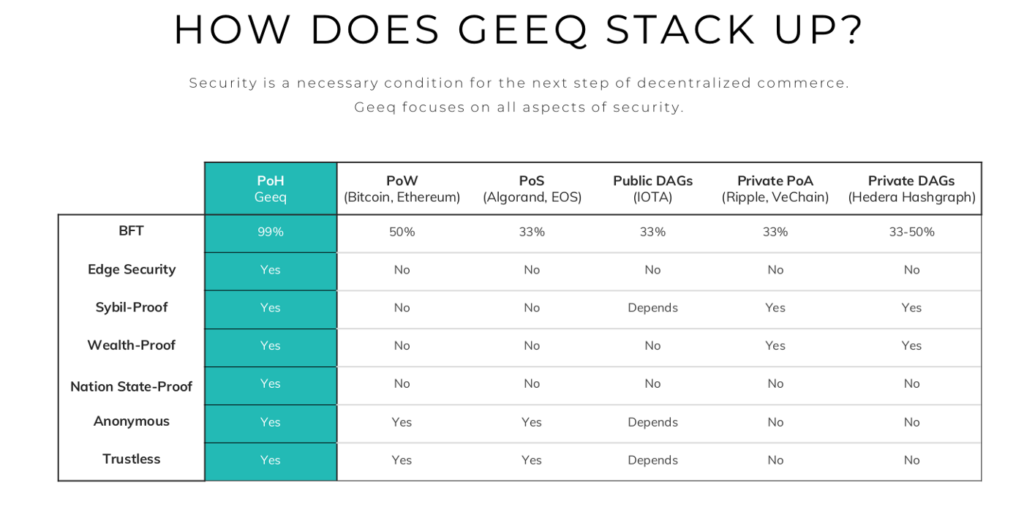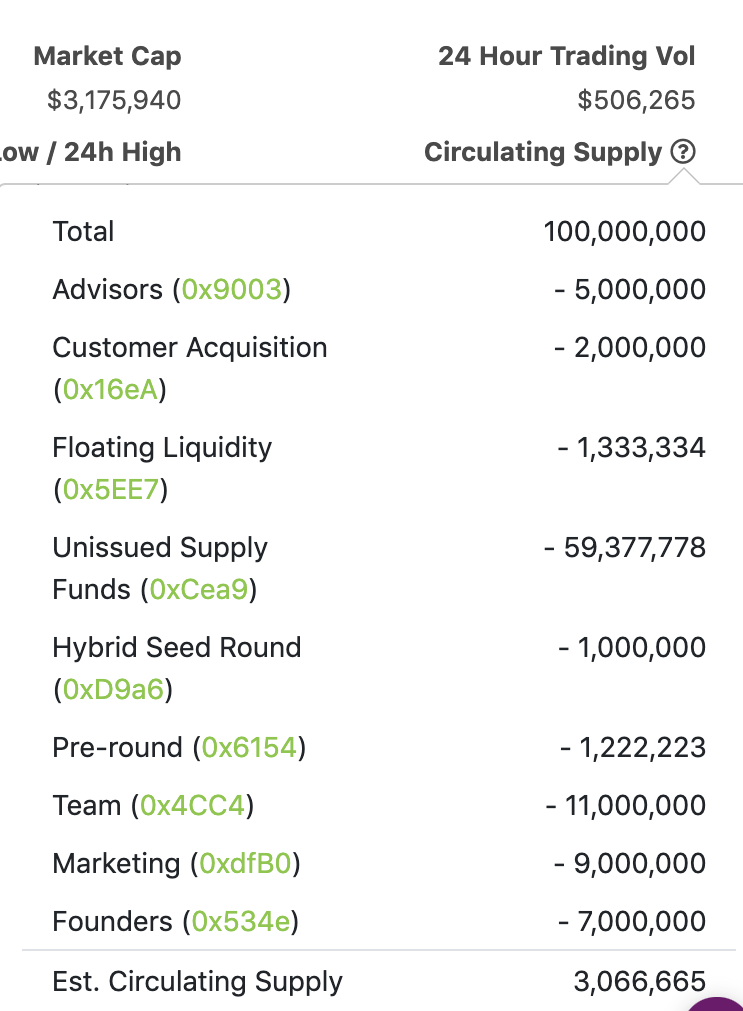
GEEQ is a platform of independent, interoperable blockchains. It uses a unique consensus mechanism called Proof of Honesty (POH). POH allows users to determine whether a node follows certain rules, and is behaving honestly. It requires less validators, but still maintains a high level of security. POH is 99% Byzantine Fault Tolerant, and is invulnerable to 51% attacks!
The Geeq platform consists of multiple independent blockchains. This architecture allows for unlimited scalability, high tps, high security, and real decentralization.
Other important features:
- Transaction costs of around 1/100th of a cent!
- Each chain can run on a different ruleset. A chain can even run Solidity!
- Upgradeability
- Separation of validation and application layers.
- An innovative token design allows the $GEEQ token price to steadily grow with adoption, instead of wildly fluctuating.
Here are some important links:
What is Proof of Honesty (POH)?
Proof of Honesty is a unique consensus protocol. It provides high security, with low computational resources. POH requires that a node proves its honesty, before a transfer is made. A POH network only requires one honest node to function. This is what is meant by 99% Byzantine Fault Tolerance.

How Can a Node Verify its Honesty?
A node shows it is truthful, by creating records to show it follows certain rules. If a ledger follows these rules, it is considered honest. A user can verify this within the client software, before a transfer is made.
Geeq Separates Validation and Application Layers for Better Security
Geeqchains runs validation and application layers on separate chains.
The validation layer does not contain smart contracts. Its simplicity minimizes the attack surface. The validation layer only does token transfers, and fee payments.
The application layer allows business logic, smart contracts, native tokens, dapps, and specialized data. Each chain can run a different ruleset. A Geeqchain can even run Solidity and Ethereum smart contracts!

How Nodes Police Each Other
Nodes can police and audit each other. They do this using a system called the Catastrophic Dissent Mechanism (CDM). Nodes can earn the Good Behavior Bond (GBB), if they are catch another node being dishonest.
Standout Features of GEEQ
Upgradability without Hardforks – Hardforks are disruptive. Geeq allows for a more elegant way to upgrade. A new chain can be created to replace, or fix the old chain. Users have the option to migrate to the new chain, or stay with the old one.
Very High Security – Geeq’s central focus is security. The network has 99% BFT. This makes it resistant to 51% attacks, and takeover from state or high resource actors.
Other security features:
- Separate validation and application layers.
- Nodes can audit each other to win the node’s collateral, or Good Behavior Bond.
- A final layer of security called Edge Security, verifies a node’s honesty via user client software. High security is one of the main focuses of the GEEQ blockchain.
Interoperability – the separation of the validation and application layers, allows GEEQ tokens to move across chains with different rulesets. Geeqchains can even be configured to run Solidity and Etherum smart contracts.
MicroPayments – Micropayments are possible on Geeqchains, as transfer costs are reduced to around 1/100th of a cent. This opens up new use cases like streaming payments, and IOT.
Multi-Chain Architecture – Geeq’s architecture consists of interoperable chains. This allows higher throughput, parallel processing, and improved scaling.
High Transaction Per Second (TPS) – Each Geeqchain can do 40 – 200 TPS. Transactions can also be done in parallel. So, the maximum TPS depends on the number of chains in the network (200 x N). Tests have done around 1000 transactions per second.
Stabilized Token – Geeq has a stabilized token. This is NOT the same as a stablecoin. It means that the token was designed to gain value, as the network increases in usage. $GEEQ’s price fluctuations are less dramatic.
Hub and Spoke Node Structure – Geeq uses a “hub and spoke” structure, instead of a gossip node structure. This is more efficient and cost effective for notifying nodes of transactions.
Geeq’s Highly Skilled Team
Geeq has a strong team, with a proven business history. The team is skilled in business, finance, and machine learning. Their goal is to make connections in the banking sector.
Tokenomics of GEEQ
GEEQ is a utility token. It is used to pay validators and for virtual machine services on the network. The value of the token is stabilized. As network usage grows, the value of the GEEQ token will grow with it.
$GEEQ’s total supply is 100,000,000. Its market-cap is around 3 million. It is held in just over 1300 wallets. Below is its token allocation.

Conclusion of GEEQ
GEEQ is unique. It addresses many problems facing blockchain. Its multi-chain architecture and POH consensus tackle scaling, upgradability, fees, security, and interoperability problems.
Geeq has a strong focus on security. The team wasn’t satisfied with the security of POW or POS. This is why they created POH consensus. They also separated the validation, and application layers for extra security. This separation also allows chains to have different rulesets for applications, but still accept transfers through the validation layer.
Geeq has high TPS and low costs. The multi-chain environment allows transactions to run in parallel. TPS will scale as the network grows. The low cost per transaction opens up new use cases like: streaming video payments and IOT.
GEEQ is an excellent project, but it hasn’t yet received much attention. Only 1300 wallet addresses hold the token. I think that once GEEQ has some applications running on-chain, it will gain more notice. GEEQ token holders will be rewarded as the network becomes utilized. The token price was designed to increase in value, as the network grows.
If you liked the article, please follow me @defipicks